Wanted: 26,000 farm workers to harvest Australia’s bumper crops
Farmers are desperate for hands to pick bumper crops, while a million Australians remain out of work. How did it get to this?
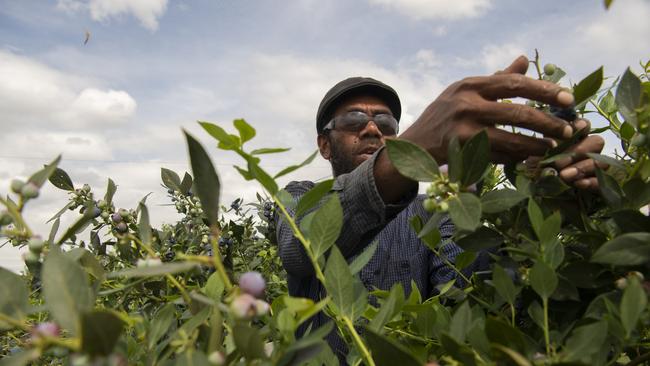
Berry farmer Amanpreet Lehl’s mobile phone just won’t stop buzzing and pinging. He is striding from the family home, past sheds, equipment and two dams, then beside rows and rows of blueberry bushes, towards a group of workers on the far side of his farm. His mobile rings again and Lehl shakes his head with a grin before he answers.
The family German shepherd Minty is gambolling ahead, barking at invisible enemies, snapping at the air. But Lehl is focused on the incessant stream of queries coming through his phone: from workers across the farm seeking advice on which crops are coming into fruit and need attention; from other producers looking for pickers and wondering whether he might share his labour force; from distributors who want to discuss the quality of Lehl’s blueberries. The frequency of calls and messages might suggest some sort of critical situation, an impending emergency. And in a way that’s exactly what is happening. As he walks and talks, through quiet fields and bushes heavy with ripening fruit, he has been thrust into the middle of an extremely complicated game of agricultural chess.
The official harvest season for some of his blueberry crops is 48 hours away. In normal circumstances his farm would be a hive of activity right now, the rows filled with young farm hands, with occasional song, with snatches of foreign languages – maybe German, maybe Spanish or French – drifting about the foliage. The harvest is the harvest. Nature has its own time-worn agenda. But courtesy of the global pandemic, harvest pickers have all but evaporated. The fruit is ripening, as it has done in these fields for decades, but there are few hands to take it off the trees. Thus the game of chess that farmers like Lehl never thought they’d have to play. Do you choose some parts of your annual crop over others? Do you take a punt on the raspberries in preference to the blueberries? It’s one thing to lose a crop to a bad season or weather event. It’s quite another to let perfectly good fruit rot on the trees for lack of workers.
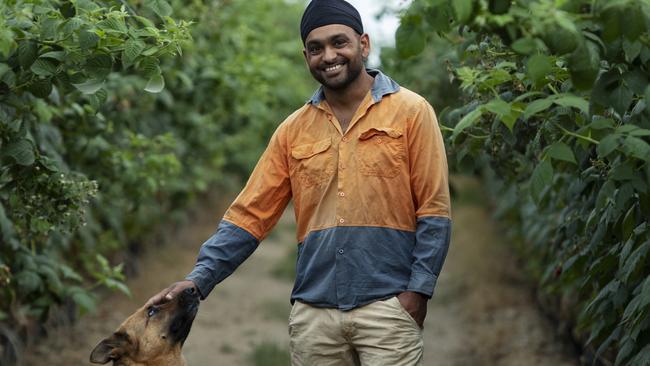
The Lehl family farm is just outside the seaside village of Corindi, 33km north of Coffs Harbour on the NSW mid-north coast. They originally grew bananas before transitioning to berries – blueberries, blackberries, raspberries. Lehl, 35, is a former high school teacher but now carries the unruffled practicality of a seasoned farmer. His composed demeanour is remarkable given the potential disaster that hangs over him like the sheets of anti-bird netting that loom above his fields. It’s Wednesday. And Lehl reckons he has until Friday or Saturday to get the berries in.
When Australia shut its borders to international visitors in March, the repercussions would ultimately find their way to Lehl’s farm, which, like many others, has always relied on a harvest workforce of young backpackers. He has about 30 workers but he needs 50. “We’re just on that precipice at the moment,” he says. “With everything going on… we can’t turn our plants off, we can’t press the pause button… we’ve still got to look after our plants. We can’t turn the farm off because then we won’t have any plants for next year or the year after. Your plants are everything.”
Meanwhile, behind Coffs Harbour, up the gullies and onto the tops of the low hills directly behind the town’s iconic Big Banana, Paul Shoker, 32, has his back to the splendid view of the Pacific Ocean and is studying his banana trees. The bunches are almost ready to be cut down. His family has two farms that produce mostly bananas, but also avocados and cucumbers. It’s a bumper crop this year. But Covid-19 has changed everything.
“In the past you’d click your fingers and there’s labour,” Shoker says. “Pre-Covid we would get carloads of French backpackers, Germans, British backpackers, looking for farm work and we’d have to turn them back. I have not had a single person approach me since Covid. Even if I put a sign out the front, I wouldn’t get people coming in now. That’s the sort of shortage we’re talking about. There is not a farm that hasn’t been affected. I can guarantee you, this season coming up… our family’s been farming now for 30 years, growing bananas… this year will be one of the most challenging years to get our crops off.”
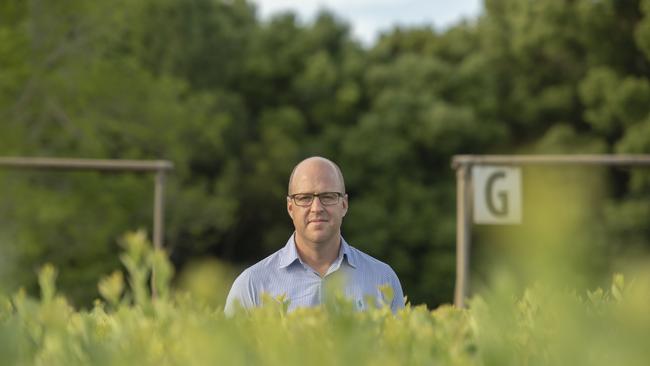
About 205km north, outside the village of Alstonville, just west of Ballina in the Northern Rivers district, Andrew Bell, managing director of Mountain Blue – one of Australia’s biggest producers of blueberries – is drumming his fingers on the desk in his office. Outside, fruit is waiting to be picked. Inside, Bell’s wall clock seems to have stopped dead. “We invest millions every year breeding new varieties, we have very expensive packing sheds and state-of-the-art machines that have cameras, where every berry gets scanned eight different times, but at the end of the day if we can’t go out there and stand in the sun and pull them off by hand there’s no point,” he says. “And fortunately, or unfortunately, we’re having a record harvest.”
He has gone as far as offering end-of-harvest incentives – a lucky draw with a prize pool of $50,000 – to attract and retain workers. And while Mountain Blue has planned and strategised around the paucity of labour, Bell’s predictions for the future are grim. “I think by this time next year, if the international borders aren’t opened and we don’t have an influx of backpackers, and if they can’t get the seasonal worker program to work properly – and you know, it’s going to take thousands and thousands of people coming over – then there will be a complete disaster right across horticulture. It will be an unmitigated disaster.”
The cry for workers on the Federal Government’s Harvest Trail website, and social media pages such as Fruit Picking Jobs on Facebook, illustrate the scope of the problem. Strawberry pickers and packers needed near Barjarg, Vic. Avocado farm hands needed near Atherton, Qld. Cherry workers needed near Yarck, Vic. Vegetable pickers needed near Ayr, Qld. Grain handlers needed in Riverina, NSW. Cherry pickers needed in NSW, VIC, TAS. Avocado packers needed near Donnybrook, WA. Grain harvest workers needed across Australia. And on and on and on.
Meanwhile, September labour force figures recorded that almost one million Australians were out of work.

In September this year, consultancy firm Ernst & Young released a 51-page report that accurately reflected chatter on vegetable and fruit farms across the nation. Farmers would need at least an additional 26,000 workers over this summer to manage a successful harvest. With the harvest peak in March next year, the report identified several regions that were likely to be hardest hit: Cairns and Wide Bay in Queensland; south-east South Australia; Shepparton and north-west Victoria; and Coffs Harbour, Grafton and the Murray region in NSW. The report added: “The deficit could be even greater if international border reopening is deferred past our current assumption of the borders opening by March 2021.”
Australia’s highly fluid casual labour market for the horticulture sector consists of four main categories: the Seasonal Worker Program (SWP) comprising workers from neighbouring Pacific Island nations; the Pacific Labour Scheme (PLS), which complements the SWP; the Working Holiday Maker (WHM) or backpacker labour force; and local Australians. Backpackers form the bulk of casual farm workers (to extend their visas they are required to work a minimum of 88 days in rural and regional Australia). There were about 140,000 here when the border was shut. By September that had dropped to 73,500.
An inquiry into the WHM program by the Federal Government’s Joint Standing Committee on Migration came up with a number of options to overcome this shortfall. Some fees for university courses could be discounted for students who agreed to work in regional and remote areas. Or the Government could develop a “Have a Gap Year at Home” campaign as a way of mobilising the nation’s youth onto farms to ensure Australia’s continued food supply.
The inquiry heard evidence that the government’s JobSeeker welfare payments, which were boosted by a $550-a-fortnight supplement in the early stages of the pandemic that’s since reduced to $250, had been a disincentive to locals who might otherwise have headed out into the fields and got their hands dirty. A spokesman for industry group AUSVEG told the inquiry: “When JobSeeker payments were raised, many growers reported they had workers collect their final pay cheques and leave because they’d rather go home and receive the JobSeeker payment than work on a farm. To put it in perspective, after tax there’s only about $250 per fortnight difference in take-home pay for a level one on the horticulture award to that of the JobSeeker payment … for many that’s a disincentive to work.”
Another industry group, the Australian Fresh Produce Alliance, told the inquiry that backpackers contributed $13 billion a year to Australia’s GDP. It warned that without adequate access to workers, the cost of fresh produce in Australia could jump by about 60 per cent.
Everyone, from growers to government, is scrambling for a solution. The moment is not lost on Prime Minister Scott Morrison. “The truth is we need to get this harvest in,” he has said. “There are jobs out there in the bush. There’s jobs out there in the Riverina. There’s jobs out there for people to be able to support our farmers get this harvest in.” Recognising that not everyone can leave their homes and families and move to a regional or rural area for short-term work, the most recent Federal budget allocated $17.4 million over two years for workers prepared to up stumps. Job seekers who relocate for agricultural work for a period of at least six weeks would be eligible, from November 1, for a $6000 relocation rebate. Growers and their industry bodies are grateful for the gesture, though it comes too late for many.
In the absence of backpackers, and with the closure of many state borders inhibiting movement, farmers turned to the Seasonal Worker Program, also reduced courtesy of Covid-19. It has been a lifeline for Australia’s agricultural industry since the pilot program began in 2008, welcoming labourers from Fiji, Vanuatu, Samoa, Timor-Leste, the Solomon Islands and other neighbouring territories. In early September, a chartered flight brought 160 seasonal workers from Vanuatu to the Northern Territory to pick mangoes. Another plane followed in the second week of October and more flights are due, but the bureaucratic hoops are formidable.
Tyson Cattle, the national public affairs manager for industry body AUSVEG and the National Farmers’ Federation Horticulture Council executive officer, says there’s no quick fix. “It’s really frustrating for the industry because, as we head into the warmer months and harvest, we could see there were going to be continued problems in the lead-up to Christmas,” he says. “We’ve seen a second flight into Darwin. That’s a good result but to be honest there were seven weeks between flights.”
Rachel Mackenzie, executive director of Berries Australia, wonders whether the agricultural sector’s heavy reliance on the backpacker workforce model is practical going into the future. “We’re really trying to get Australians into farms, onto farms,” she says. “This is a challenging one. If you’re someone who errs towards the right wing of politics you’ll say it’s because Australians are lazy and that JobSeeker is too high and that’s the problem. And if you’re on the left side of politics you’ll say it’s because they get exploited and the growers exploit the foreigners, which is not true. So I think there are a lot of ideological lenses put over this, when I actually think we don’t really know. This is not unique to Australia. Every developed economy has this exact issue. It’s complex.”
For years the fresh produce industry has been plagued with allegations of labour exploitation, underpayment and poor conditions. Conversely, growers complain they’re all tarred with the same brush when some operators do the wrong thing.
Despite the plethora of inquiries and official reports, the ongoing analysis of the agricultural work force, the governmental debates about assorted labour programs and visa modifications that might sort out the shortfall of pickers and packers, crops continue to grow, night and day, as the harvest clock ticks down.

Paul Shoker, in the shade of his banana trees, is explaining what would be expected of someone coming to work on his farm. “I’d probably start you on a basic job like trimming leaves, so I’ll get you in and you might be cutting dead leaves or whatever,” he says. “Then I might have you in the cucumbers one day, then I might say, ‘Well, I’m going to show you how to spray weeds: there’s the tractor.’ It’s a slow progression into it. I don’t get people carrying 60kg bunches of bananas on the first day, unless they’ve done the work before.”
Wages for farm labour are either by the hour, “piece rate” or calculated on the volume picked and packed, or a combination. Shoker currently pays workers $24.36 per hour. Amanpreet Lehl says his workers, on a piece rate, can take home up to $400 a day depending on how many kilos of fruit they pick. Similarly, at Mountain Blue, Andrew Bell says pickers can earn in excess of $400 a day based on the company’s set piece rate, which ensures a minimum wage plus a 15 per cent loading. “It’s a lot more money than I earned as a first-year lawyer,” Bell says.
Shoker then drifts into a reverie about the virtues of hard work and how what was once intrinsic to our identity may now be lost to the Australian character. He studied accountancy and finance at university and believes Covid-19 has unwittingly pulled back the curtain on aspects of life we all took for granted. “Right now we have a situation where local cafes and restaurants can’t even get staff because with JobSeeker they’re all paid so well,” he says. “I know it’s come back a bit now… but the other thing I’ve noticed, because we’ve got some local stores that we provide produce to, they have said to us that everyone has gone into this Covid mindset… The government has basically flicked the switch, turned everything off, put the community into hibernation, then tried to restart the economy and people are still in hibernation mode.”
He says the pandemic has exposed our over-reliance on overseas workers. “My approach, and I think the industry approach, has always been we want our locals to work on farms, but that’s simply not occurring,” Shoker says. “The biggest thing I’m finding with locals is that they struggle to do early starts. In summertime we’ll do a 6.15am start; it’s not that early. People just simply aren’t job-ready.
“We are ultimately competing in a pool of low to semi-skilled workers in our community. A lot of them don’t want to work. I have no qualms about that. But don’t waste my time.” He needs a minimum of 15 workers to see him through the harvest. At present he has eight on the books.
Lehl is resigned to losing part of his crop. He’s a realist. “There’s nothing the government can do now to get us out of the issue we’re in,” he says. “This week and next week the blueberry season is at its peak and then it’s going to drop off. We might lose 40 or 50 per cent of our crop next week. It’s too late.”
He has six permanent locals employed on the farm. “The issue with local employment depends on the calibre of the people,” he says. “We’ve gone through local employment agencies in the past and to be frank some of those guys, they’re just not in it. You know, when you can sit at home on this JobSeeker, there’s no incentive for these guys to get out in the sun and pick blueberries because, look, you do have to work hard. The backpackers here, you know, even some of our locals who are experienced at picking, they’re earning $40 an hour plus. But if they’re picking 12, 13, 14 kilos an hour to do that, and you get some of these locals who have never picked before and they’re picking a kilo or a kilo and a half an hour, it’s untenable. If we pay them by the hour we’ll be paying 10 times more than what the fruit is worth at the market. We’re better off pruning the fruit off the tree because otherwise we’re paying out of our pocket.”
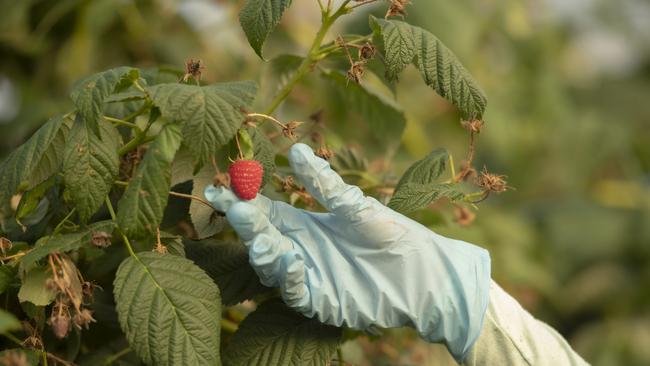
At the same time, Lehl understands that fruit picking does not provide the stable ongoing work many locals require. “The locals might get work for four, five, six weeks of the year picking blueberries… it’s not a stable income for them for the rest of the year. The thing with the backpackers and the working holiday guys is that because they have that visa they’re happy to travel from region to region and follow that harvest trail. And it works for them. And it’s great for them to be filling the gaps. But we can’t get the fruit off the trees without that sudden influx of pickers when you really need them. Without them there’s not an industry.”
The frustration for Andrew Bell up in the Northern Rivers is that he still can’t secure a full complement of workers, even though there are many jobless people in the region. “In April, at the height of a global pandemic, when I drove through Lismore… there was a line outside Centrelink hundreds of metres long,” he recalls. “We needed people to do some construction work, putting up nets, building tunnels, so it wasn’t even harvest work, it was hourly wages. We onboarded 33 people. Four of those people were locals, and they lasted a couple of weeks.”
Nobody has seen the likes of the current chronic labour shortage. “If 50 people were ready to go tomorrow we would take them, maybe even 100,” Bell says. “We’ve established a competition. $50,000 worth of prizes. First prize is $10,000, second $5000. And 35 people get a $1000 cheque at the end of the season via attendance, consistency… if you’ve stayed through to the last day we need you, you’ll keep your tickets and we’ll do the draw.
The competition kicked off in September. “It’s difficult to quantify [the impact],” Bell says. “But certainly there was an uptick, yeah. Unfortunately, local Australians weren’t interested.” Why not? “The first challenge is actually getting an Australian to do the work, and the second challenge is their efficiency,” he says. “Last year we ran the data at the end of the season. The highest performing group were the Pacific islanders, the second highest performing group were your traditional backpackers, and bringing up the rear by a bit was our local contingent, in terms of kilos picked per hour.
“It’s attitude, I think; I really don’t know. It’s hard work. Let’s be serious. Working on a farm, you’re in the elements, you’re potentially remote, you’ve got to work fast to make good money, and it’s hard work. Backpackers come and work at the farm – 88 days in a regional area – to get a second year visa; the seasonal workers, they’re here because they’re often from poor, remote parts of Vanuatu or Timor. They’re here to earn money for their family. They’re here to work.”
In the smoko room at the Alstonville farm, Thomas Resnick, 27, from Buenos Aires, Argentina, is taking a break. He and his partner Victoria arrived in Australia just before the pandemic struck. Both lost their jobs in hospitality and decided to go fruit-picking to extend their holiday visas. “Some days it is hard work, yes,” Resnick concedes. “But I think work is work, more so in these hard times. If you want to stay one more year this is not too bad, that’s the truth. We feel really lucky. I miss my family and friends but I feel really lucky and happy to be here.”
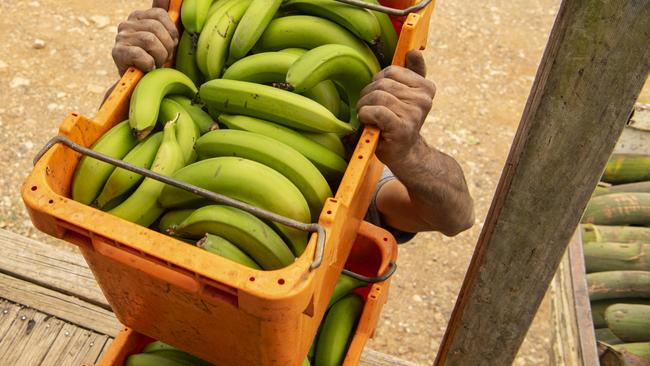
Could this become a genuine national food security issue? Is it too early to have that conversation? Might the armed forces be called in to harvest crops and save produce? Bell says: “I couldn’t see the army getting involved but one thing we actually looked at, there’s a number of local organisations around here, the Rural Fire Service and the State Emergency Service, and we’re saying, will you come out and work on the farm on the weekend, get some volunteers, and pick the fruit, and whatever you earned picking, we’ll match it with a donation to your organisation. We’ve thought about things like that. There were a lot of people who were interested. These local groups can’t do their Bunnings sausage sizzles anymore, but if they could get some volunteers and come and pick berries for a couple of days we’ll match it with a donation.”
A stoic Amanpreet Lehl walks past the “summer” blueberry crops, due to come to full ripeness at the end of November and into early December, and then takes a right past a tilled field where two men are working in the sun. “This is where the blackberries are going in next week,” he says. “The thing is, these blackberry plants are worth $50,000. They were ordered two years ago. If I cancel the order I’ve still got to pay for it. The nursery has already spent a lot of money bringing these plants to where they are now. Two years. And the igloos [protective covers], they’re on a ship on the way here and they’ve cost us $100,000. It’s got to work.”
Finally, he greets a handful of pickers over on the property’s eastern flank. One of those labouring away at the blueberry bushes is his wife, Rajpreet. Together they have two children – Munsa, 10, and Harsaaj, eight. “I’m here to pick,” she says with a smile. “It’s fine. I prefer the outdoors. I used to be an accountant. But it’s much better being out here than in an office.” Her husband nods: “We’re happy to work 70 or 80 hours a week if we get the reward for doing that. But we should have at least 40 or 50 pickers here.” The Lehls are practical people. They’re farmers. Life moves forward.
Two weeks after my visit I check how things are going. With the inclement weather and no pickers, Lehl says he’s now six to seven days behind the fruit. He has had to prioritise some blueberry “blocks” over others and is unsure whether the temporarily abandoned blocks will be salvageable. “We’re hanging on by a thread.”
Things aren’t much better for Paul Shoker. He says that in the next fortnight he will have to make crucial decisions about abandoning some crops. “We haven’t been able to harvest any of the crops because of the weather system that hit most of NSW,” Shoker says. “With less labour and less time to harvest, the situation is now critical.”
Andrew Bell at Mountain Blue is in a similar position. In the next week he’ll have to decide whether to abandon some blocks altogether. “It’s very frustrating after the efforts you put in all year,” he says. “But we’re farmers. And if you’re going to be a farmer, you’ve got to be resilient.”

To join the conversation, please log in. Don't have an account? Register
Join the conversation, you are commenting as Logout